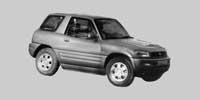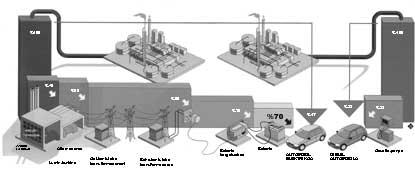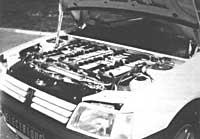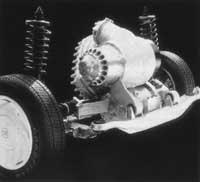Electric car pollution
1997/07/01 De la Taille, R. Iturria: Elhuyar aldizkaria
Elhuyar. In the magazine Zientzia eta Teknika we have taken charge of the electric car (see page 68, on page 60, “The electric car, ready for the road” and on page 81, on page 10, “Smaller and smaller cars”). On this occasion, however, we will focus on the pollution that the electric car produces indirectly.
Advantages of the electric motor
As is known, the electric car loads some batteries in which when turning the electric motor with the accumulated electric power, the vehicle advances. The electric motor has an annular stator and in the middle the cylindrical rotor turns on its axis.
When the electric motor is running, it does not emit noise and the pedestrian does not hear that the electric car comes. As for silence, it is like the bike, the perfect machine. That's why we can find it anywhere in our life: drills, washing machines, fridges, computer hard drive, hair dryer, photo camera, shaving machine, workshop machines, etc. The electric motor has not been used to move machines that until now move autonomously, such as planes, cars and motorcycles.

Another advantage of the electric car is that it does not pollute the environment and this advance has been revealed on many occasions. It must be said, however, that the car with electric motor always needs a battery or an electric cable that provides energy. Electric trains or trolleybuses running through several cities have an electric cable above, but for cars it does not seem an adequate solution.
Pollution in central station
The electric car needs a battery, but the battery has to be charged and for this, an electric cable is also needed. Therefore, from the point of view of pollution, what happens at the other end of the electric cable is worrying.
Electricity itself is not present in nature, except in the clouds in case of storm (the use of this electricity generates great problems). Electricity is a type of energy that can be applied to any type of energy, that is, it does not produce or lose energy, it is transformed. For this reason, to obtain electrical energy, it is necessary to transform another type of energy.
In the European countries of obtaining electric power there are different types of power plants: hydraulic, nuclear and thermal. The use of electricity from hydraulic power plants for the charge of batteries does not imply any type of contamination. In the central one the turbines are operated with the difference of water level and no smoke or waste is generated.
If the battery power supply is a nuclear power plant (in France 76% of the electricity is nuclear), the pollution is different. Instead of the cars emitting gases in the cities, radioactive waste is generated in the central one and the subject of radioactive waste remains unsolved at all. However, in some cities the pollution caused by cars is huge, so the solution of nuclear power stations would be satisfied. In fact, the only nuclear reactor would be enough to move three million cars.
If the electric power for batteries is supplied by a thermal power plant that burns coal or oil, the problem persists. The electric car does not eliminate pollution. Only carry out the transfer. The polluting gases are not emitted by streets and roads but by the fireplace of the thermal power plant. However, it is true that the control and neutralization of harmful gases that leave alone and dispersed by thousands of exhaust pipes is more difficult than to treat in a single large fireplace of the thermal power plant.
It should not be forgotten that in many countries most of the electricity comes from thermal power stations: Denmark 90%, Great Britain 71%, Germany 66%, United States 66%, Japan 66%, etc.
Figures of yields
According to some, in countries that obtain most of the electric power in the thermal power plants, the electric car will cause greater pollution. For this purpose, they use performance figures. And when you move from one type of energy to another the performance is never 100%. A part is always lost in transformation.
For example, when we spin the electric dynamo, if the energy we take from the network is 10 kWh, the mechanical energy that is given in the dynamo axis will be 8 kWh when the performance is 80%. Other 2 kW.h will be mainly lost in heat form by Joule effect. In each transformation part is lost and when the transformations are numerous one after the other, what really takes advantage at the end of the chain can be a very small percentage.

In the current conventional car, the fuel flows directly from the tank to the exploding engine and its performance ranges from 25 to 30%. In the electric car that loads the thermal power station, the fuel energy goes from the tanks of the power plant to the steam turbine and from the turbine to the alternator. From the alternator to the transformer, high voltage line, again goes to the transformer, low voltage line, battery and finally to the car engine.
In the conversion of fuel to turbine the performance is 40% and in the alternator of 95%. Of 90% in the transformer and high voltage line and of 70% in the charge of batteries. Finally, the performance in the transformation of the vehicle's electric motor from the battery is 70%. Therefore, the overall performance during the whole process is 0.4 x 0.95 x 0.90 x 0.7 x 0.7 = 0.167 or 16.7%, that is, less than that of conventional blast engines.
However, it must be clarified that transport from oil refinery to gas stations spends more energy than when it is done to thermal power stations. On the other hand, it would be necessary to analyze the amount of energy that is spent in the refinery to obtain the liter fuel that is taken to the petrol stations and the liter that is taken to the thermal power stations.
Final conclusion of the Final Conclusion
The electric car still has some obstacles to overcome. The important thing is that in light batteries accumulate a lot of electrical energy so that the vehicle reaches a great autonomy and the speed required. However, the materials used in batteries today are not ecological: lead, sulfuric acid, sulphur, sodium, nickel, cadmium, etc. Once used, they must also be recycled.
So far we have taken into account the worst cases of the electric car (which is loaded with the energy generated by the thermal power plant), but in general, and compared to the pollution generated by the current cars, undoubtedly the electric car is a good solution. In theory there may be better ways, of course, and we will have to investigate, but it cannot be denied that the proliferation of electric cars will be thanks to the environment and our health.

Gai honi buruzko eduki gehiago
Elhuyarrek garatutako teknologia






